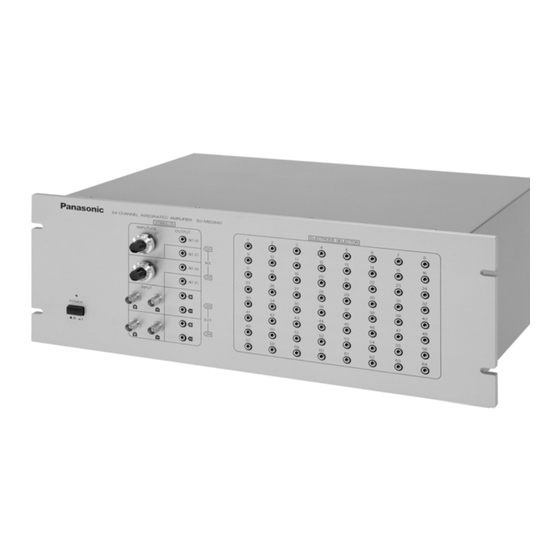Summary of Contents for Alpha MED Scientific MED64
- Page 1 An advanced and easy-to-use solution for in-vitro Electrophysiology Operating Instructions MED64 Integrated Amplifier P/N: SU-MED640P...
-
Page 2: Safety Precautions
Safety Precautions Before using this unit please read these operating instructions carefully. Take special care to follow the warnings indicated on the unit itself as well as the safety suggestions listed below. Keep these precau- tions handy for future reference. The unit may be used only in the operating conditions and positions specified manufacturer. -
Page 3: Environmental Conditions
Service - Never attempt to repair, disassemble or modify the unit if there seems to be a problem. A serious electric shock could result if you ignore this precautionary measure. - If a problem occurs during operation (smoke is detected, etc.) contact your dealer immediately. - Disconnect the power supply if the unit will not be used for a long time. -
Page 4: Components And Their Functions
The input terminals (+ & -) for an external stimulus isolation unit. (12) ELECTRODE SELECTOR The terminal(s) used to select the stimulus electrodes on the MED probe. Use a MED64 stimultion cord to con- nect to either terminals (2) through (5) or terminals (8) and (9). -
Page 5: Reference Electrodes
Back Panel (13) INPUT For connecting to the MED probe, through the MED-CO3 connector, to the amplifier. (14) OUTPUT(1-32CH) For connecting the output of channels 1-32 to the to the first A/D board in the computer. (15) OUTPUT(33-64CH) For connecting the output of channels 33-64 to the to the second A/D board in the computer. (16) SIGNAL OUTPUT BNC connectors used to send analog outputs from selected recording channels to an external amplifier, signal processor, or other device (e.g. - Page 6 Connection to other components Usage of internal stimulus amplifier (Components and cables indicated with dashed lines are not included) MED Connector Connector cable (included) A/D board cables (NI SH-100100) A/D board in PC A/D board in PC (NI PCI-6071E) (NI PCI-6071E)
- Page 7 Using the MED64 amplifier with External Devices (stimulator, isolator, oscilloscope). Caution: Do NOT connect MED64 stimulation cord on the internal stimulator outputs (CH1 or CH2). (Components and cables indicated with dashed lines are not included.) External Stimulator External Isolator BNC cables...
-
Page 8: Precautions During Use
Precautions during use Always, turn ON the amplifier power BEFORE starting up the software. The software sends information to the amplifier for initialization of the internal stimulators and other features (e.g. filtering) necessary for accurate recording of data. Failure to do so (i.e. turning ON power to the amplifier after the software starts up) will lead to inaccuracies in stimulus delivery and the data recorded. -
Page 9: Specifications
Specifications [Recording unit] Channels Input impedance 100 MΩ Maximum output voltage +/- 12 Vp Output impedance 2.2 kΩ Amplification x 1000 (60 dB) Low-cut filter 0.1, 1, 10 and 100 Hz (PC control, Stimulation 64 CH switch) (4 settings, 12 dB/oct) Frequency range (low-cut: 0.1 Hz) 0.1 Hz to 10 kHz (+0 dB to -3 dB) Residual noise... - Page 10 December, 2009 Manufactured by Alpha MED Scientific Inc. Alpha MED Scientific Inc. 209 Saito-incubator U.S. Patents: 5,563,067 Oct. 1996. 5,810,725 7-7-15, Saito-asagi, Ibaraki Osaka, Sept. 1998. 6,132,683 Oct. 2000.6,151,519 Nov. 567-0085, Japan 2000. Phone: +81-72-648-7973 http://www.med64.com ©2009 Alpha MED Scientific Inc.





Need help?
Do you have a question about the MED64 and is the answer not in the manual?
Questions and answers